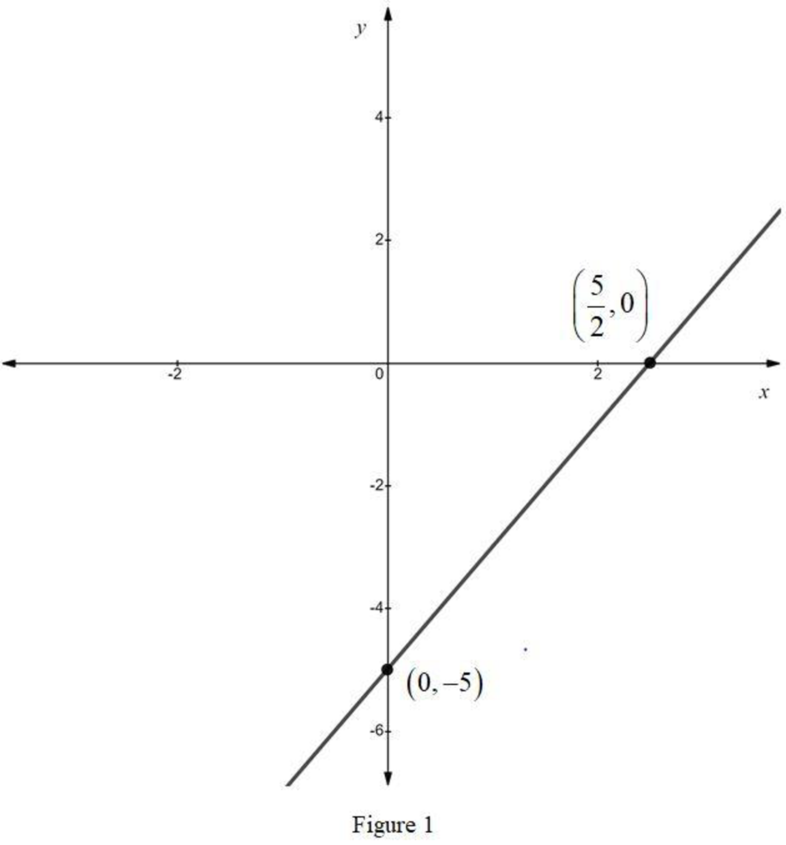
a.
The slope and the y-intercept of the linear function
a.
Answer to Problem 1RE
The slope and the y-intercept of the linear function
Explanation of Solution
Result used:
Slope of a function:
The slope of a function
The y-intercept of a function:
The y-intercept of a function
Calculation:
Compare the function
Therefore, the slope and the y-intercept of the linear function
b.
The average rate of change of the function
b.
Answer to Problem 1RE
The average rate of change of the function
Explanation of Solution
Result used:
The average rate of change of a linear function:
The average rate of change of a linear function
Calculation:
For the given function
Use equation (1) and obtain the average rate of change of the given function as follows.
Therefore, the average rate of change of the function
c.
To graph: The function
c.
Explanation of Solution
Consider the function
Rewrite the above function as
Substitute the value
Hence, the x-intercept of the given function is
From part a., the y-intercept of f is given by
Therefore, the point that represents the y-intercept is
Use the points

From Figure 1, it can be observed that the intercepts of the function
d.
Whether the function
d.
Answer to Problem 1RE
The function
Explanation of Solution
Result used:
A linear function
Calculation:
The slope of the function
Since the value 2 is positive, the function
Want to see more full solutions like this?
Chapter 4 Solutions
Pearson eText Algebra and Trigonometry -- Instant Access (Pearson+)
- In simplest way, For each quadratic relation, find the zeros and the maximum or minimum. a) y = x 2 + 16 x + 39 b) y = 5 x2 - 50 x - 120arrow_forwardIn simplest terms and step by step Write each quadratic relation in standard form, then fi nd the zeros. y = - 4( x + 6)2 + 36arrow_forwardIn simplest terms and step by step For each quadratic relation, find the zeros and the maximum or minimum. 1) y = - 2 x2 - 28 x + 64 2) y = 6 x2 + 36 x - 42arrow_forward
- Write each relation in standard form a)y = 5(x + 10)2 + 7 b)y = 9(x - 8)2 - 4arrow_forwardIn simplest form and step by step Write the quadratic relation in standard form, then fi nd the zeros. y = 3(x - 1)2 - 147arrow_forwardStep by step instructions The path of a soccer ball can be modelled by the relation h = - 0.1 d 2 + 0.5 d + 0.6, where h is the ball’s height and d is the horizontal distance from the kicker. a) Find the zeros of the relation.arrow_forward
 Algebra and Trigonometry (6th Edition)AlgebraISBN:9780134463216Author:Robert F. BlitzerPublisher:PEARSON
Algebra and Trigonometry (6th Edition)AlgebraISBN:9780134463216Author:Robert F. BlitzerPublisher:PEARSON Contemporary Abstract AlgebraAlgebraISBN:9781305657960Author:Joseph GallianPublisher:Cengage Learning
Contemporary Abstract AlgebraAlgebraISBN:9781305657960Author:Joseph GallianPublisher:Cengage Learning Linear Algebra: A Modern IntroductionAlgebraISBN:9781285463247Author:David PoolePublisher:Cengage Learning
Linear Algebra: A Modern IntroductionAlgebraISBN:9781285463247Author:David PoolePublisher:Cengage Learning Algebra And Trigonometry (11th Edition)AlgebraISBN:9780135163078Author:Michael SullivanPublisher:PEARSON
Algebra And Trigonometry (11th Edition)AlgebraISBN:9780135163078Author:Michael SullivanPublisher:PEARSON Introduction to Linear Algebra, Fifth EditionAlgebraISBN:9780980232776Author:Gilbert StrangPublisher:Wellesley-Cambridge Press
Introduction to Linear Algebra, Fifth EditionAlgebraISBN:9780980232776Author:Gilbert StrangPublisher:Wellesley-Cambridge Press College Algebra (Collegiate Math)AlgebraISBN:9780077836344Author:Julie Miller, Donna GerkenPublisher:McGraw-Hill Education
College Algebra (Collegiate Math)AlgebraISBN:9780077836344Author:Julie Miller, Donna GerkenPublisher:McGraw-Hill Education





